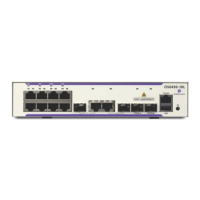Configuring VLAN Stacking Configuring VLAN Stacking Services
OmniSwitch AOS Release 7 Network Configuration Guide March 2011 page 27-19
-> ethernet-service sap 20 sap-profile map_pbit
Note the following when associating a profile with a VLAN Stacking SAP:
• To change the profile associated with the SAP back to the default profile, specify “default-sap-profile”
for the profile name. For example:
-> ethernet-service sap 20 sap-profile default-sap-profile
Use the show ethernet-service sap command to display the SAP configuration, which includes the profile
association for each SAP.
Configuring a UNI Profile
The ethernet-service uni-profile command is used to create a VLAN Stacking UNI port profile. The UNI
profile determines how control frames ingressing on UNI ports are processed. For example, the following
command creates a UNI profile to specify that VLAN Stacking should discard MVRP frames:
-> ethernet-service uni-profile uni_1 l2-protocol mvrp discard
A default UNI profile, named “default-uni-profile”, is automatically associated with a UNI port. The
default UNI profile specifies how control frames ingressing on the UNI port.
To delete a UNI profile, use the no form of the ethernet-service uni-profile command. For example, the
following command deletes the uni_1 profile:
-> no ethernet-service uni-profile uni_1
Use the show ethernet-service uni-profile command to view a list of profiles that are already configured
for the switch. This command also displays the attribute values for each profile.
Associating UNI Profiles with UNI Ports
After a UNI profile is created, it is then necessary to associate the profile with a UNI port or a UNI link
aggregate. When this is done, the current profile associated with the port is replaced with the new profile.
The ethernet-service uni uni-profile command is used to associate a new profile with a UNI port. For
example, the following command associates the uni_1 profile to UNI port 1/1:
-> ethernet-service uni port 1/1 uni-profile uni_1
To change the profile associated with the UNI port back to the default profile, specify “default-uni-
profile” for the profile name. For example:
-> ethernet-service uni port 1/1 uni-profile default-uni-profile
Use the show ethernet-service uni command to display the profile associations for each UNI port.

